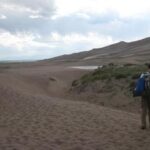Coastal erosion is a natural redistribution process that continually changes beaches, dunes and bluffs. From waves, tides and groundwater seepage to construction and boating, there are both natural and human causes of coastal erosion. In contrast, coastal erosion also helps redistribute land that can further protect the mainland and human lives.
Facts
Coastal erosion occurs along U.S. Pacific and Atlantic coastlines as well as along the Gulf. It also occurs along the Great Lakes coastline and anywhere there are large bodies of flowing water. “The Mississippi Delta is the most rapidly eroding coast in the U.S.A.,” says Robert Stewart of Texas A&M; University. Woods Hole Oceanographic Institution calls coastal erosion a major national economic concern in the amount of home and property damage that occurs.
Natural Causes
Beach erosion accelerates when major storms, such as Hurricane Katrina, or tidal waves hit. Also blamed for growing erosion are significant weather events such as nor’easters and El Nino. Rising water levels also affect coastal erosion, and global warming affects how quickly icebergs melt in the polar region which leads to rising levels. Each coastal area erodes at its own pace, some at a rate of several feet per year, others at a rate of inches per year.
Human Causes
Levee construction has stopped sedimentation in the Mississippi Delta in Louisiana, and “the delta is now rapidly sinking below sea level,” says Texas A&M;’s Stewart. He notes that dredging of canals, which helps salt water reach further inland, causes death of trees and vegetation that would normally stabilize the coastline. Wind blowing along the canals creates waves that erode the coast and create storm surges. Dams prevent sand from restoring the coastlines, and structures built to limit erosion create further erosion in the long term.
Benefits of Erosion
Higher levels of water increase hydropower generation and allow ships to carry more cargo in the Great Lakes, states University of Wisconsin. According to WHOI, eroding glacial landforms create beaches, dunes, barrier beaches and other natural structures. Dunes and bluffs, which are reinforced as a result of coastal erosion, prevent damage from storm-induced high water, and are a reservoir for beaches and offshore sandbar and shoal formations, states the State of New York.
Negative Effects
High levels of water cause coastal homes to flood or slide into the water, industrial and commercial facilities that are in low-lying areas are impaired or shut down, and beaches and marina docks get submerged. Coastal Erosion damages wastewater collection systems, contaminates drinking water supplies, and it interferes with public power supplies, says the State of New York. It can also endanger human lives.
References
New York State Department of Conservation, Coastal Erosion http://www.dec.ny.gov/lands/28923.html
Ross, C., Keeping Coastal Erosion At Bay http://www.hgtvpro.com/hpro/nws_ind_nws_trends/article/0,2624,HPRO_26519_5601752,00.html
Texas A&M; University, Coastal Erosion http://oceanworld.tamu.edu/resources/oceanography-book/coastalerosion.htm
University of Wisconsin, 20 FAQs about Great Lakes Water Levels and Coastal Erosion http://www.seagrant.wisc.edu/communications/LakeLevels/index.html
Woods Hole Oceanographic Institute, Shoreline Change and the Importance of Coastal Erosion http://www.whoi.edu/seagrant/education/focalpoints/shoreline.html
Reference:
- Dees, K., Galveston Coastal Erosion coastal.tamug.edu/am/Galveston_Coastal_Erosion_an_overview_of_causes,_problems_and_wh
- Science Daily, Wave Patterns Point to Coastal Erosion ‘Hot Spots’ www.sciencedaily.com/releases/2000/03/000324094458.htm


